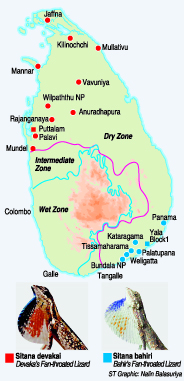News
‘Weli katussa’ species unique to Sri Lanka
Three young researchers have determined that Sri Lanka has its own species of fan-throated lizards – creatures that puff out an extraordinary frill around their throats to warn off intruders – and that in fact the island has two distinct varieties.
Until now it had been assumed that the fan-throated lizards found in Sri Lanka were the same as in India.
Researchers Thasun Amarasinghe, Sameera Karunarathna and Madhava Botejue studied lizard specimens in the Calcutta and Chennai museums and realised the Sri Lankan lizards were different.
They widened their research to fan-throated lizard specimens at other foreign museums and confirmed their theory, also finding that Sri Lanka has two species of this lizard: one found in the south-eastern coastal belt from Bundala to Kumana and another in the north-west, north of Puttalam.
The two species were named Sitana devakai and Sitana bahiri to honour leading biologists Professor Devaka Weerakoon and Professor Mohammed Bahir.
“Prof. Weerakoon was one of the first scientists to initiate research on the biodiversity of the north of Sri Lanka after the restrictions of the war ended so we named the lizard found in the north, Sitana devakai,” Sameera Karunarathna said.
The team also wanted to honour Professor Mohammed Bahir for his extensive research that established freshwater crabs as the biggest endemic group in the country. Since he came from the southern part of the island the fan-throated lizard found in the south was named Sitana bahiri.
The fan-throated lizard, just 5cm long, mostly inhabits coastal areas including sand dunes, hence its Sinhala name weli katussa (sand lizard). Its hind legs have four toes unlike other lizards that have five toes. The researchers say this adaptation helps them to live in arid areas where temperatures are high and to move about efficiently on sand.
The most interesting feature of the species is the pouch on the throat of male lizards. When a territory guarding lizard spots an intruder, it quickly advances on the trespasser and oscillates this large, coloured pouch in a display of threat. The frill found on Si. devakai is pink and blue while S. bahiri is less colourful.
The findings, by Mr. Karunaratna, Mr. Amarasinghe, Ms Botejue and two colleagues, Ivan Ineich and Patrick Campbell were published in the prestigious journal Zootaxa earlier this month.
Last year, Mr. Karunaratna and Mr. Amarasinghe took the lead in finding two other endemic lizards, Calotes pethiyagodai and Calotes manamendrai (both from the Knuckles forest) named after Rohan Pethiyagoda and Kelum Manamendra-Arachchi who contributed towards the country’s biodiversity.
Sri Lanka is home to 21 species of lizards, 19 of them endemic to the country.

